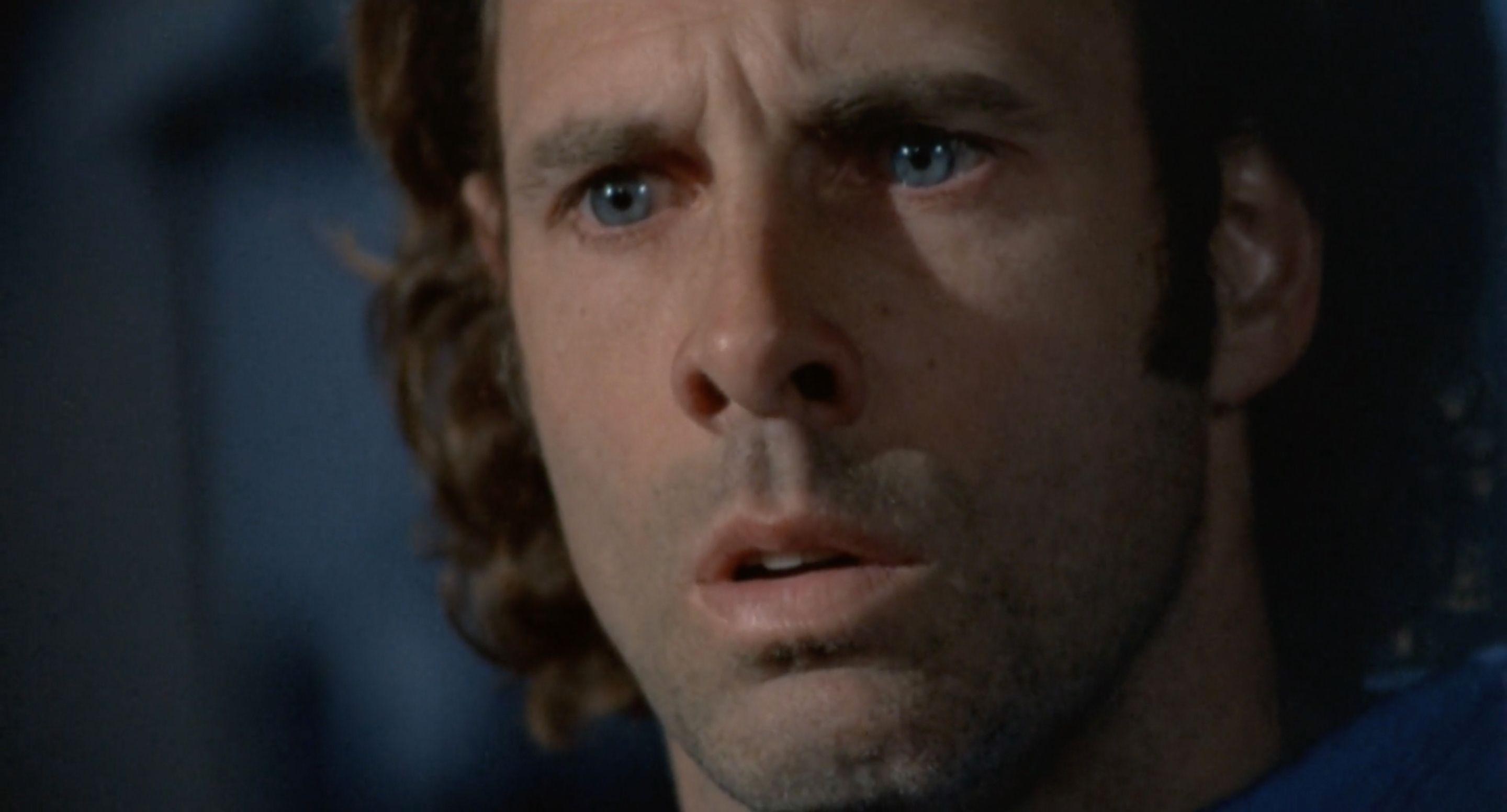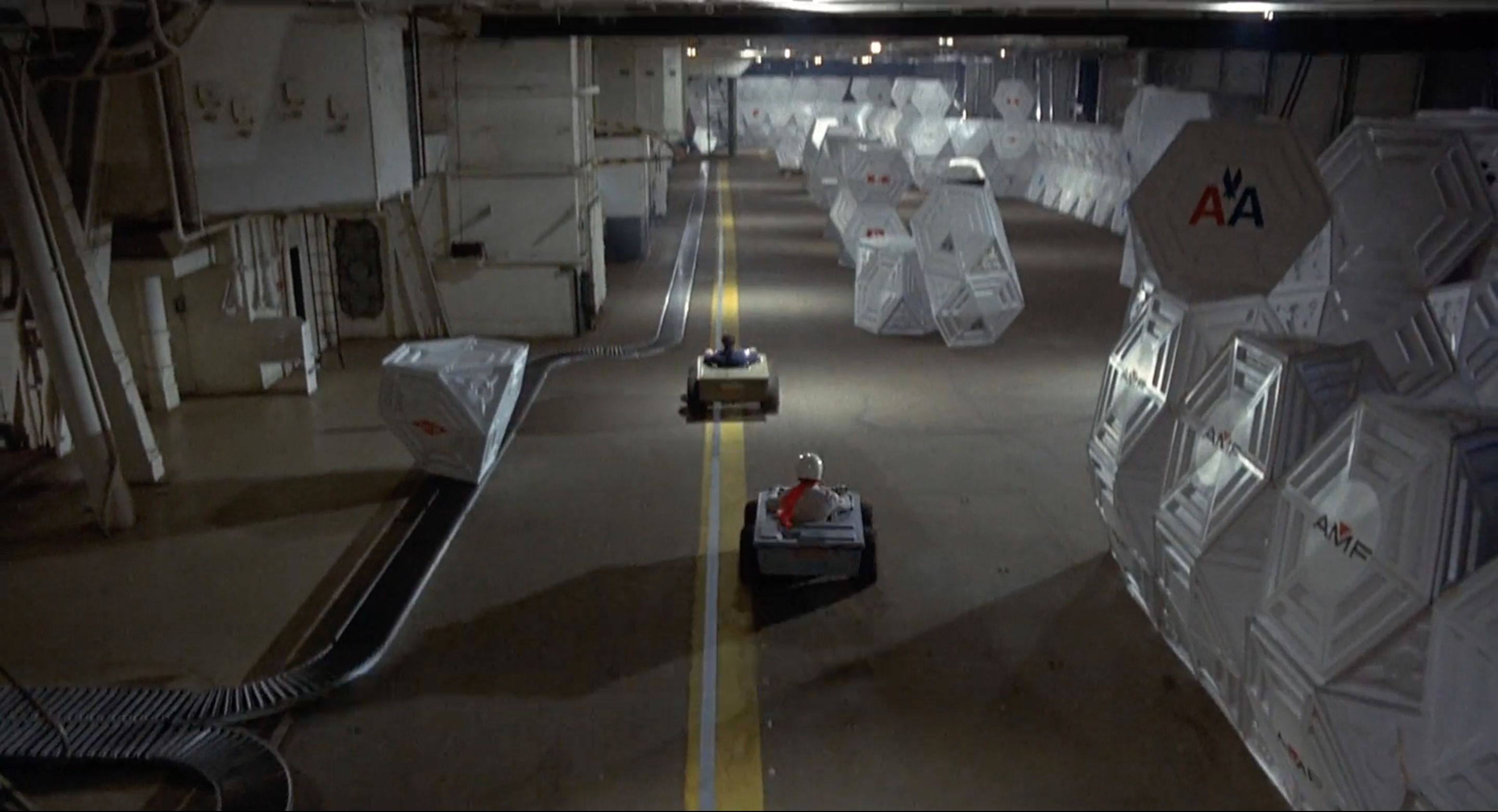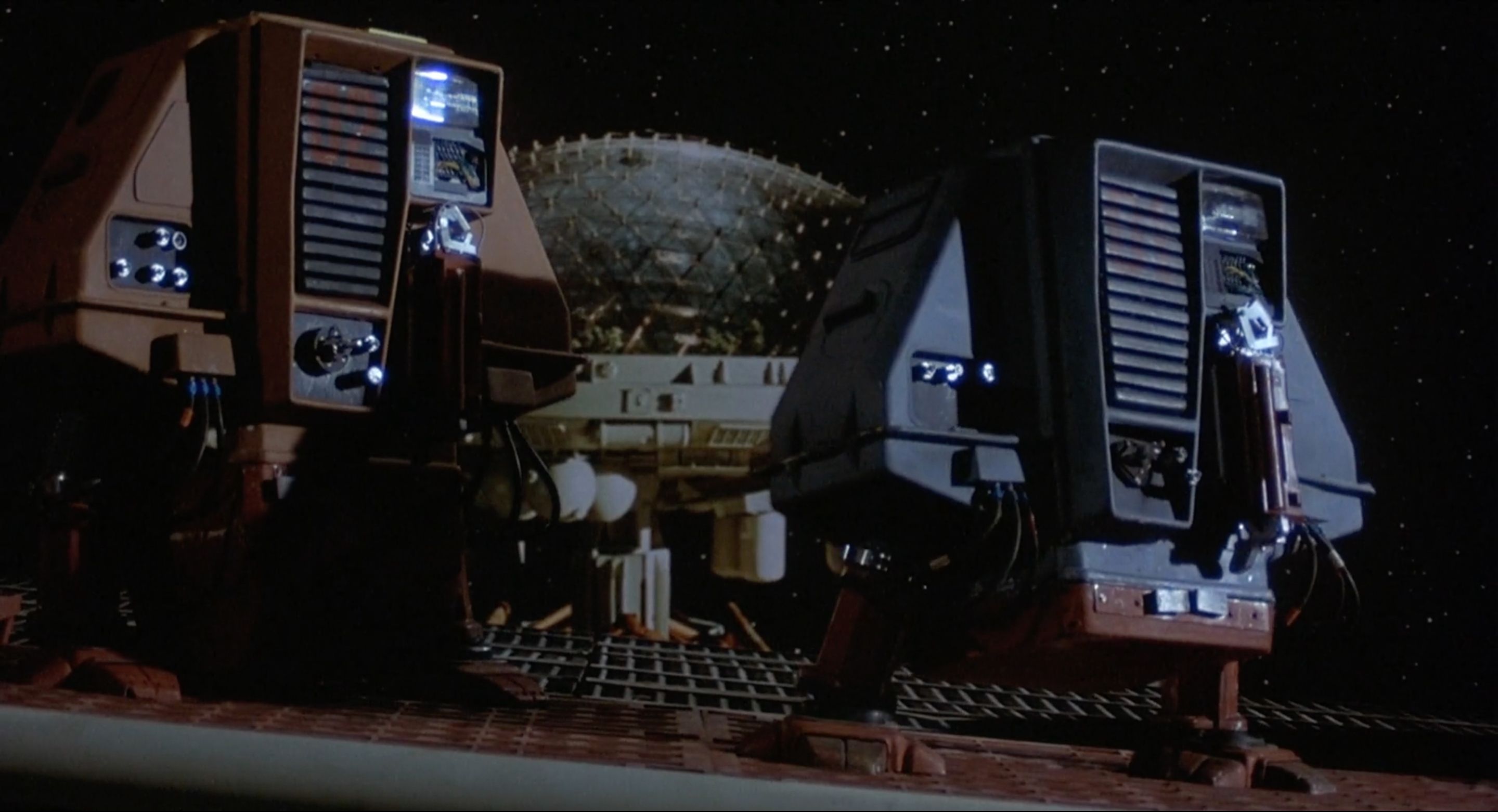 Originally posted 4/25/22 on Substack.
Originally posted 4/25/22 on Substack.
This is the second Against the ’70s Request Line film, and it’s from subscriber Martin McClellan. Thanks, Martin! If you’d like to request a specific 1970s movie for me to cover, you can do by subscribing either here or over at my Patreon. Also, inevitably, there are spoilers here. Read with care. Thanks!
What is it? Silent Running, directed by Douglas Trumbull, written by Deric Washburn & Michael Cimino (!) and Steven Bochco (!!), and starring Bruce Dern, Cliff Potts, Ron Rifkin, Jesse Vint, and introducing Mark Persons, Cheryl Sparks, Steven Brown and Larry Whisenhunt as Huey, Dewey and Louie.
First viewing? Yes, although I confess I started watching it on my DVR (remember those?) around 2006 or so and wasn’t impressed with the first, what, five minutes or so? I mean, I kind of get where I was coming from back then, but still.
What’s it about? In the future, the Earth’s forests and other plant life have been transplanted to spaceships and sent to orbit near Saturn. Freeman Lowell (Dern), the only crewmember who gives a damn about ecology, believes the ships will be recalled back and he’ll be put in charge of a new department overseeing the replanting of the forests. Instead, the order is given to blow up the forests and return home. Lowell takes extreme measures to keep the forests from being destroyed.
What are your thoughts about it? Silent Running is so simple and straightforward, I have almost nothing to say about it. It’s about as WYSIWYG as a film can be. Despite the heaviness at its core, it’s a breezy 89 minutes of watching Bruce Dern garden, play poker with robot drones, fix things and play live-action Mario Kart. It’s a perfect “lazy Saturday afternoon prone on the couch” movie. (Here at Against the ’70s, a movie like that is no demerit. Some might call it a requirement.) You could call it a hang-out jam, albeit one run through with loneliness, guilt and regret.
![Director Trumbull famously worked on 2001: A SPACE ODYSSEY, but while that movie’s SFX hold up, the models here never look like anything but straight up Aurora. Not sure if that’s due to Kubrick’s skill and/or budget, or perhaps that 1080p doesn’t do these 1972 effects any favors. (See also DRAGONSLAYER [1981, Matthew Robbins]).](https://cdn.blot.im/blog_0fba11d6687b43da99df61c9f07e12d0/_image_cache/137468f3-c357-4c4f-8e7d-37d32738e6f6.jpg) Director Trumbull famously worked on 2001: A SPACE ODYSSEY, but while that movie’s SFX hold up, the models here never look like anything but straight up Aurora. Not sure if that’s due to Kubrick’s skill and/or budget, or perhaps that 1080p doesn’t do these 1972 effects any favors. (See also DRAGONSLAYER [1981, Matthew Robbins]).
Director Trumbull famously worked on 2001: A SPACE ODYSSEY, but while that movie’s SFX hold up, the models here never look like anything but straight up Aurora. Not sure if that’s due to Kubrick’s skill and/or budget, or perhaps that 1080p doesn’t do these 1972 effects any favors. (See also DRAGONSLAYER [1981, Matthew Robbins]).
Let’s talk about that heaviness. Silent Running is about a man faced with a horrible, nearly impossible choice: he can either passively watch as something non-sentient he loves is destroyed, or he can stop that destruction at the cost of murdering three relatively blameless men. Either one could be a movie about a guy living with a decision; the filmmakers went with the more dramatic one. That decision, however, is rooted in a story decision at the heart of Silent Running, a meta-choice that most viewers can’t help but anxiously, subconsciously worry at like a canker sore. But to get to that, let’s talk about Bruce Dern for a moment.
If one were to write a précis of Freeman1 Lowell, it would probably go something like: green thumb gardener, friend to bunnies, hippie-ish, a protector of the natural world. Lots of actors could’ve played this role: big stars like Robert Redford or Dustin Hoffman, or smaller names like Peter Fonda, Keith Carradine, Michael Murphy or a pre-fame Richard Dreyfuss. Bruce Dern is a completely counterintuitive choice. He’s tall and imposing, and acts like he knows it. Even when calm or joyful, there’s a glint of fire and madness behind his eyes. He’s a live wire who could flail and electrocute someone at any moment. (Imagine, say, Michael Shannon as Gandhi; that’s the level of disconnect for me here.) Dern as Lowell, I think, subtly alters the script. As written, he’s an outcast from his three fellow astronauts, completely differing in philosophy, his obvious love for the trees and plants marking him as softer, possibly weaker, definitely ineffectual. Dern’s intensity recasts that. The other three don’t respect him, but they’re also wary of him, a little afraid, only a little because there’s three of them. It’s obvious in the poker scene that while Lowell knows he’s an outcast from these other three, he’s not a shrinking violet about it. No, he goes the other way with it — lording his obvious superiority over them, a bit of a bully.
 I’d say SILENT RUNNING is the first “blue collar astronaut” film, where the crew aren’t scientists or military or action heroes. Technically, John Carpenter’s DARK STAR got their first, but wasn’t released until 1974. 2001: A SPACE ODYSSEY gave us the idea that space travel is, as Isaac Brock said, boring, which is key to this concept, but Bowman and Poole were scientists.
I’d say SILENT RUNNING is the first “blue collar astronaut” film, where the crew aren’t scientists or military or action heroes. Technically, John Carpenter’s DARK STAR got their first, but wasn’t released until 1974. 2001: A SPACE ODYSSEY gave us the idea that space travel is, as Isaac Brock said, boring, which is key to this concept, but Bowman and Poole were scientists.
It’s a strange casting choice, but not an unsuccessful one, maybe even a necessary one. Whatever seeming mismatch there is between role and actor, Dern is, as always, magnetic, the kind of actor who needs no dialogue because his face expresses everything, the kind of actor you watch because you’re never quite sure what he’s going to do next. (For more of that, check out his role as the antagonist in 1978’s The Driver.) Dern makes the key moment of Lowell’s existence — the decision to kill his fellow crewmembers — easier to believe.
Question, though. Why, exactly, is the command given to nuke the last remaining forests? On the face of it, it makes no sense. The forests were sent up into space so that the Earth could be flattened2 and made 75 degrees worldwide. That’s hard to swallow scientifically, but it’s a truth of the fiction, so swallow it we must. It still doesn’t explain why the forests were removed, why they paid astronomical sums (pun not intended) to send them into space, and why all the way to Saturn. (My personal canon reason: the disembodied, bottled head of Trump won reelection. It explains all three!) Here’s the thing, though: all of that doesn’t matter, because the absolute inscrutability of this plot point is necessary for the film to work3. The story asks us to identify with, and root for, a guy who murders three people. (Okay, the first guy might’ve been an accident, but he definitely murders the other two.) The thing that would cause him to do this, if we want to keep our empathy with him, must be something so enormously absurd and unjustified that the decision must be not one of right and wrong, but of will to go through with it. It’s signifcant that we never see the people who give this order or authorize it. They are a faceless, inhuman force, which makes Lowell’s decision more comprehensible. If there was even a tiny bit of rational reason behind the action, we’d have a tiny bit of doubt in Lowell’s actions. And if we doubt his actions, our position towards him is different, and we’d have a different movie. Lowell could be seen as a villain, and we would hold the film at a distance. Unlike its spiritual antecedent, 2001: A Space Odyssey, this is not a movie that wants distance. (For one, it’s almost built entirely out of close-ups on Dern.)
 One of those Dern close-ups. This is the point where everything has calmed down, relatively, on the ship and the enormity of what he’s done hits him.
One of those Dern close-ups. This is the point where everything has calmed down, relatively, on the ship and the enormity of what he’s done hits him.
To the film’s credit, it never backs away from the consequences of Lowell’s actions. For the rest of the story, loneliness and guilt have him shook. Yet, it’s never suggested that letting the forests be blown to smithereens was ever an option. The film opens with extreme close-ups of the biodome’s flora and fauna, so close you might initially think it’s on Earth, and ends with us watching the biodome float off into the emptiness of space. The guardianship of these lifeforms under the eye of a simple robot and the unfeeling vastness of space is preferable to that of humans.
 Go ‘way, Kartin’. (I just noticed the kicky racing neckerchief one of the guys wears.)
Go ‘way, Kartin’. (I just noticed the kicky racing neckerchief one of the guys wears.)
How many stars out of five? Honestly, I can’t decide between three and three and a half. Three and a quarter?
Where can I stream it? As of this writing4, Silent Running isn’t available to stream for free. However, you can rent it from Apple TV, Amazon, Google Play, YouTube, Vudo - Fandango, Microsoft Store, and DirecTV. You can buy it from these same vendors.
What can we take from it? This next part’s long, so I’ll get to it: drones! We can take drones from it! Also, we can come up with some rules for programming the drones. Take a look below!
 DRONE
DRONE
Level: 2 (Level 1 for combat purposes; 3+ on a d20 to hit a drone, 3+ on a d20 to avoid being hit by a drone.)
Description: Drones are robots, approximately three feet tall, with wide, wedge-shaped bodies supported by two short, piston-like legs. They have one short articulated metal “arm” that can manipulate objects, one camera “eye,” and a flap-like cartridge slot that’s a bit like a mouth, though no sound emits from it.
Motive: To follow its programming. A drone’s baseline program commands it to take care of its assigned spaceship.
Environment: Drones can be found on any spacefaring vehicle over a certain tonnage.
Health: 6
Damage Inflicted: 1
Armor: 1 from their thick shell-like container.
Movement: Due to their stubby legs, it takes a drone two actions to cross a Short distance. Don’t rely on one to be speedy!
Modifications: “Off the shelf” drones perform welding and mechanical repair tasks at level 4. A drone’s skills can be modified with programs (see below).
Combat: “Off the shelf” drones have no combat ability. They will not attack nor defend themselves. This can be modified with programs (see below).
Interaction: Unless given specific programming and modified hardware, a drone cannot speak. It can attempt to communicate with lights, beeps, and gestures with its arm. Deciphering this communication is a level 1-5 task, depending on the complexity of the message. However, drones can understand human languages perfectly.
Use: While exploring an uncharted, uninhabited planet, the PCs discover a drone, with no ship in sight. How did it get here? What is it doing? And why does it have so many program slots filled in?
Loot: Each drone can be broken down into 1d3 cyphers.
GM Intrusion: A drone appears out of nowhere, getting in the way and causing a mishap.
 DRONE PROGRAMMING
DRONE PROGRAMMING
Drones were designed to support the crew of a spaceship in the operation and maintenance of the ship. All drones perform these tasks at level 4. However, all drones can be reprogrammed. Every drone has at least one slot on the top of its body that can hold a program. Ships that have drones have a dedicated station for writing programs to alter or add to the drone’s original programming. If a character wishes to write a new program for a drone, use the following rules to adjudicate the process.
First, the player determines the scope of the program they wish to write, as well as its difficulty level. The scope is what the program does; this is usually expressed in one or two new skills, as well as the possibility of new behaviors that complement the skills. The difficulty level is the number the player will roll against to determine if the program is successfully written, as well as determines the level of the newly programmed skills. For example, if a player is writing a chess program, and chooses a difficulty of 5, then the drone will be level 5 in chess tasks once the program is successfully written. Furthermore, for every skill added past two, the difficulty is raised by 1.
Next, the character must spend time writing the program. The amount of time required is shown on the chart below, determined by the difficulty level chosen. The time spent need not be consecutive, and it is assumed that characters will use downtime between adventures to apply towards the total. Also, when the scope and difficulty are chosen, the character may ease the difficulty with skills, as well as apply Effort to lower the difficulty level. This new difficulty level is called the effective difficulty level. Characters are limited to the amount of Effort they can apply by their Tier. If the difficulty is lowered to 0 or less, then the base time to write the program is 30 minutes.
Difficulty 1: 1 hour
Difficulty 2: 2 hours
Difficulty 3: 4 hours
Difficulty 4: 8 hours
Difficulty 5: 16 hours
Difficulty 6: 32 hours
Difficulty 7: 64 hours
Difficulty 8: 128 hours
Difficulty 9: 256 hours
Difficulty 10: 512 hours
Once the character has put in the time necessary to write the program, the player may then make an Intellect task against the effective difficulty level. If the roll is a success, the program works as intended. If the roll is a failure, then the program… does not work. There are two possibilities. First, the program simply doesn’t do anything. Second, the program works, but not in ways that were intended. Perhaps the drone now shuts off or reboots at random or inopportune times, or adds an unwanted ability or behavior. Regardless, the only solution is to debug the program. The character must spend half the amount of time originally spent writing the program, then make the Intellect task again, this time with the effective level reduced by 1, modified by applicable assets and Effort as usual. If this fails, the character can repeat the process as many times as needed until success (or decides to give up.)
EXAMPLE: Lowell decides to write a chess program for the drone. He wants the drone to be a tough opponent, so he decides it will be a level 7 program. This means that Lowell will have to spend 64 non-consecutive hours writing it, and at the end of that time, roll 21+ on a d20 to be successful. Luckily, Lowell is skilled in programming, and he uses one level of Effort, each of which eases the difficulty by one. Now the effective difficulty level of the program is now 5 (15+ on a d20) and it will only take him 16 hours to complete. After 16 hours of non-consecutive work on the program, he inserts it into the drone to see if it works. Lowell rolls… and gets a 12. The program is a failure. Lowell decides to debug the program. This will take half the time it took to originally write the program, so instead of 16 hours, it will take 8. The chess program is still a level 7 program, but the effective difficulty level before was 5, and now debugging reduces the effective difficulty level once more, to 4. Lowell decides to apply another level of Effort, bringing the effective difficulty down to 3. Lowell needs a 9+ on a d20. Lowell rolls… and gets a 12. Success! After 24 hours of work, the drone now has a level 7 chess program plugged into it. Lowell can now have his ass kicked at chess on the regular.
Medical Program
This gives the drone skill in diagnosis and surgery. Additional skills or abilities that could be added include first aid, or an electrocardiogram or x-ray device.
Combat Program
This improves the drone’s attack and defense capabilities, so that it acts as a level 2 creature (6+ to hit the drone on a d20, 6+ to avoid being hit by the drone). It can also use its arm to be more effective in combat, raising the damage done by 2. Drones probably shouldn’t be combatants.
Farming Program
This gives the drone skill in agronomy and forestry. Additional skills or abilities that could be added include botany, ecology, or chemistry.
NEXT TIME, ON AGAINST THE ’70S: Master of the Flying Guillotine (1976, Jimmy Wang Yu))